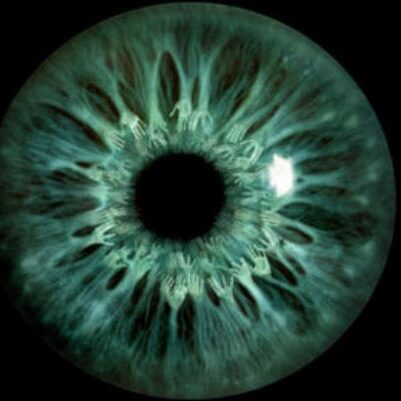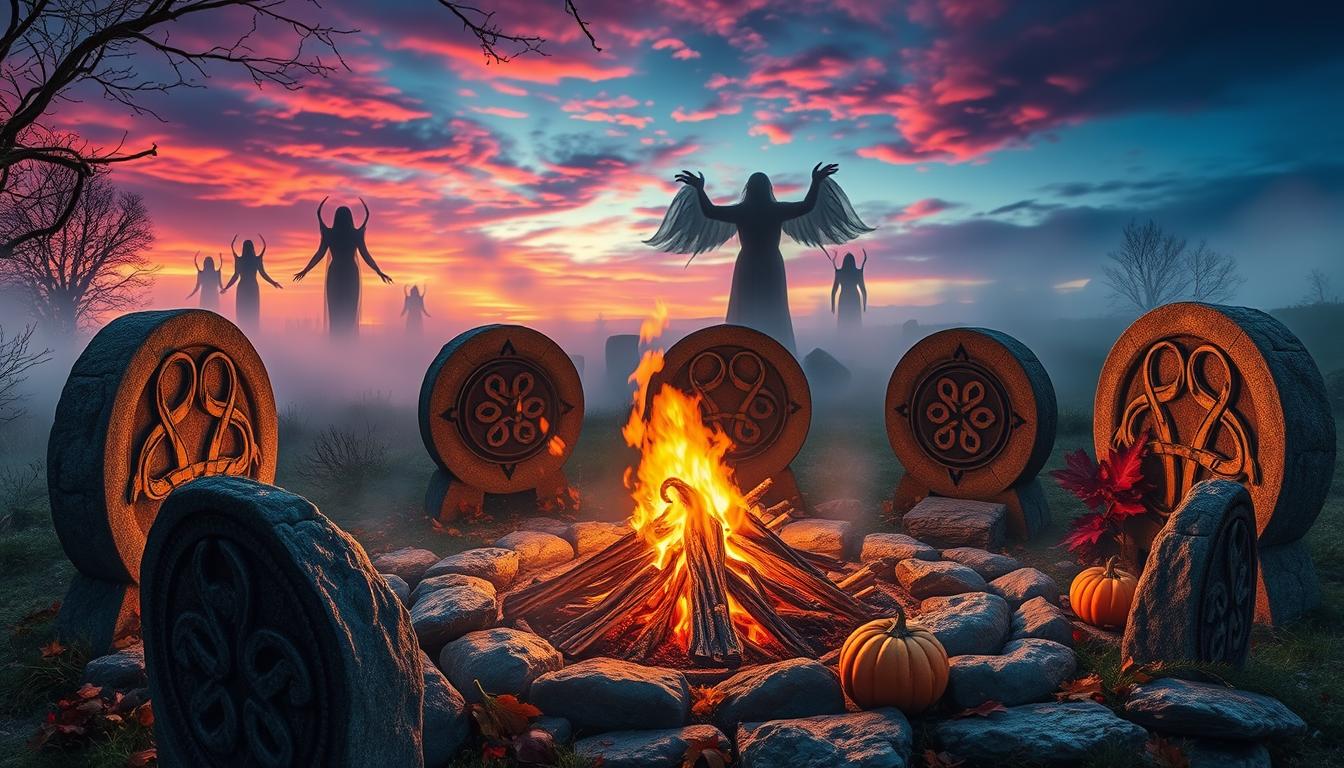As autumn arrives, the air gets crisp and leaves turn colors. This brings excitement for Halloween, a holiday many love. But have you thought about where this spooky celebration comes from? Halloween’s story goes back thousands of years to ancient Celtic traditions and beliefs.
In ancient Celtic lands, Samhain (pronounced “SAH-win”) marked the end of summer and the start of a new year. The Celts thought that on this night, the line between life and death got thinner. This let spirits and otherworldly beings move freely. To avoid these spirits, the Celts wore masks and costumes. They lit bonfires and left food offerings to keep the spirits away, a tradition that might have led to trick-or-treating today.
Key Takeaways
- The origins of Halloween come from the ancient Celtic festival of Samhain, a time to celebrate the end of summer and the start of the new year.
- The Celts believed that on this night, the line between life and death got thinner, letting spirits roam freely.
- Wearing masks and costumes was a way for the Celts to avoid being seen by spirits. Leaving out food was a way to keep the spirits happy.
- These old pagan rituals and beliefs greatly influenced today’s Halloween celebrations.
- The holiday’s colors, black and orange, represent the end of summer and the start of autumn, coming from the Celtic festival of Samhain.
Ancient Celtic Festival of Samhain
Samhain, an ancient Celtic festival, marked the end of summer and the start of winter about 2,000 years ago. It was the most important of the four Celtic festivals. It was like a prelude to our New Year’s Eve today.
Celts and the New Year Celebration
Samhain was a time of change for the Celts. They believed the veil between life and death was at its thinnest. They lit sacred bonfires for three days and nights. These fires were for offerings to their gods to help crops and animals in the next year.
Supernatural Beliefs and Bonfires
The Celts believed in supernatural things during Samhain. They wore costumes and masks to keep away spirits. They also had a tradition called “dumb supper” where they invited ancestors to join them.
Samhain is where Halloween started. Its traditions like bonfires, costumes, and honoring the dead live on today.
“Samhain was marked as the most significant of the four quarterly fire festivals for ancient Celts.”
| Samhain Celebration Facts | Details |
|---|---|
| Duration | The celebration of Samhain lasted three days and three nights. |
| Military Presence | There were thrones prepared for military commanders during Samhain in Ireland. |
| Alcohol Consumption | Documents mention six days of excessive alcohol consumption during Samhain, typically mead or beer. |
| Prominent Stories | One of the popular Samhain stories was “The Second Battle of Mag Tuired.” |
| Bonfires | In the middle ages, bonfires called Samghnagans were personal Samhain fires closer to farms. |
| Violent Games | In Wales, men partook in violent games during Samhain by tossing burning wood at each other. |
Roman Influence and Christian Adoption
As the Roman Empire grew, it brought Celtic regions under its rule. This led to a blend of traditions. The Roman festivals of Feralia and Pomona merged with the Celtic Samhain. Feralia honored the dead, and Pomona was for the goddess of fruit and trees.
The Pomona festival might have started bobbing for apples, a popular Halloween activity. In the 8th century, the Catholic Church created All Saints’ Day on November 1 to honor Christian martyrs and saints. November 2 became All Souls’ Day, a day for remembering the dead.
The Church wanted to replace Samhain with a Christian holiday. So, the day before All Saints’ Day, now called All Hallows’ Eve, turned into Halloween.
| Roman Festival | Significance | Connection to Halloween |
|---|---|---|
| Feralia | Commemoration of the passing of the dead | Incorporated into the Samhain festival |
| Pomona | Celebration of the Roman goddess of fruit and trees | Likely led to the tradition of bobbing for apples |
The Christian adoption of Samhain helped shape today’s Halloween. This includes All Saints’ Day and All Souls’ Day.
What are the origins of Halloween?
Halloween’s roots go way back to the ancient Celtic festival of Samhain. This was a pagan celebration that marked the end of summer and the start of the new year. The Celts thought this was when the line between life and death was the thinnest. This let mischievous spirits move freely.
The Catholic Church added some Samhain traditions to their holidays like All Saints’ Day and All Souls’ Day. This mix of old and new traditions led to the modern-day Halloween we know.
Scholars think early Samhain celebrations might have included human sacrifice. The Celts did this to scare away ghosts and spirits. Trick-or-treating could have started from spirits visiting homes or people asking for “soul cakes” at doors.
Over time, Halloween got more commercial, with books, movies, costumes, and parties becoming popular. In the 20th century, especially in the U.S., Irish immigrants brought their Samhain traditions. This included carving pumpkins and using black and orange colors.
| Key Dates and Events in the Origins of Halloween |
|---|
| Around 2,000 years ago: The Festival of Samhain celebrated by the Celts |
| Spread of Christianity: All Saints’ Day and All Souls’ Day incorporated Samhain traditions |
| 19th century: Irish immigrants bring their Halloween traditions to the United States |
| Early 20th century: Halloween becomes increasingly commercialized |
| 1930s-1940s: Trick-or-treating gains momentum to deter pranks and vandalism |
Now, Halloween is a worldwide event celebrated with costumes, trick-or-treating, and pumpkin carving. These traditions have evolved over centuries. They all trace back to the ancient Celtic festival of Samhain, a time when the line between life and death was thought to be the thinnest.
Halloween Traditions in America
In colonial New England, Halloween was rare because of strict Protestant beliefs. But in Maryland and the south, it was a big deal. As different cultures mixed, a unique American Halloween started to take shape. This included fun parties and telling scary stories.
Colonial Celebrations and Irish Immigrants
In the mid-1800s, Irish immigrants came to America, fleeing the Potato Famine. They brought Halloween traditions like carving pumpkins, which were originally turnips in Europe. This mix of cultures created the Halloween we know today.
| Tradition | Origin |
|---|---|
| Pumpkin Carving | Adapted from the Irish tradition of carving turnips |
| Trick-or-Treating | Evolved from the 19th-century practice of “guising” in Scotland and Ireland |
| Bobbing for Apples | Originated as a 19th-century fortune-telling game for matchmaking |
These cultural changes shaped today’s Halloween in America. Now, it’s a big part of our culture, with lots of events for both fun and business.
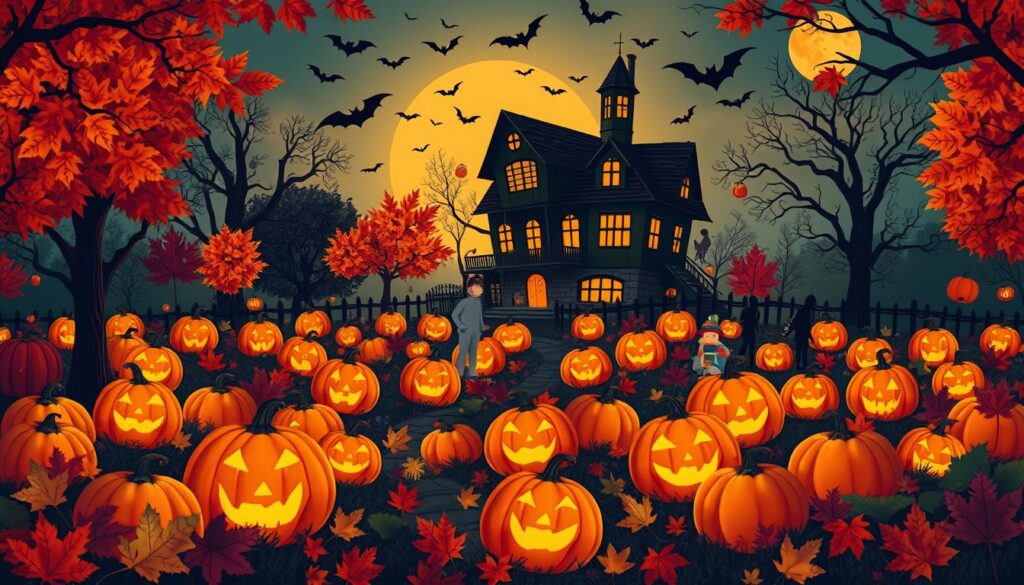
“Halloween began to be celebrated throughout the whole country in the United States by various communities after mass Irish and Scottish immigration in the 19th century.”
Jack-o’-Lanterns and Pumpkin Carving
The tradition of carving jack-o’-lanterns started in Ireland. The Irish carved turnips and beets to keep evil spirits away. When they moved to America, they found pumpkins perfect for their spooky designs. The name “jack-o’-lantern” comes from a story about Stingy Jack, who tricked the Devil and was spared from Hell.
Pumpkin carving is now a big part of Halloween. In 2018, Americans harvested over 1 billion tons of pumpkins. The National Museum of Ireland shows a plaster cast of a carved turnip, proving pumpkins have been linked to Halloween for a long time.
Today, carving jack-o’-lanterns is an art. Steve Clark is the fastest pumpkin carver in the world, making amazing designs. Events like the Great Jack O’ Lantern Blaze in Sleepy Hollow, New York, and the Dallas Arboretum and Botanical Garden’s Autumn at the Arboretum show off thousands of carved jack-o’-lanterns and pumpkins. These displays amaze people with their creativity and spookiness.
“The popularity of jack-o’-lanterns remains strong, as they have evolved to symbolize a welcoming sense of community, embodying good values and neighborliness.”
Whether you’re carving a simple face or a detailed design, pumpkin carving is a key part of Halloween. So, get your tools ready, choose the best pumpkin, and show off your creativity this Halloween!
Trick-or-Treating Origins
The tradition of trick-or-treating goes way back to the Celtic festival of Samhain. People left food out to keep spirits happy. Another idea is that it comes from “guising,” a Scottish custom. Here, kids and adults in disguise would ask for food and money, saying prayers for the dead on All Souls’ Day.
Souling and Guising Traditions
“Souling” was a tradition in the Middle Ages in Britain and Ireland. People would go around in costume, performing for food or drinks. In Scotland and Ireland, “guising” started in the 16th century. Kids would go around in disguise, getting food, coins, or small gifts.
The first guising in North America was in 1911 in Ontario, Canada. By the 1920s, boys in places like Thorntonhall, South Lanarkshire, were doing it for rewards.
Trick-or-treating has been around in the U.S. and other countries for over a hundred years. It became a big part of American culture by 1951. Now, it’s a favorite activity for kids and adults alike, changing and growing worldwide.

| Country | Trick-or-Treating Tradition |
|---|---|
| United Kingdom | Guising and souling |
| Ireland | Guising and souling |
| United States | Trick-or-treating |
| Canada | Trick-or-treating |
| Mexico | Calaverita |
Scary Costumes and Masks
The origins of Halloween costumes and masks go back to the ancient Celtic festival of Samhain. The Celts thought the veil between the living and the dead was thinnest then. They believed evil spirits could cross over. To avoid these spirits, they wore disguises and masks to blend in.
Now, we wear scary costumes on Halloween to represent many characters, from supernatural beings to pop culture icons. Masks are still key, with many choosing spooky or funny ones to add to their look.
Halloween costumes have changed a lot over time. In the Renaissance, they were fancy for masquerade balls. But by the 20th century, they were more about fear and old superstitions. Now, they’re often cute, funny, or about superheroes.
Masks have always been a big part of Halloween. They were common in Scotland and Ireland by the late 1800s. Soon, they spread to the U.S. and Canada. Today, masks are popular not just for Halloween but also for safety reasons.
The TRU47 mask is a modern example of mask technology. Made from pure silver, it’s antimicrobial and has a 2-ply design for comfort. These masks, including ones for kids, offer protection and style.
“Costumes and masks have been an integral part of Halloween celebrations for centuries, evolving from a means of confusing evil spirits to a way of expressing creativity and embracing the spooky spirit of the holiday.”
Black Cats and Superstitions
Black cats have been surrounded by superstitions for a long time. Their dark fur is often linked to bad luck and the mysterious. This belief goes way back to the Middle Ages. Back then, black cats were thought to be symbols of the Devil or witches’ “familiars.” These were supernatural beings that helped with dark magic.
The link between black cats and Halloween goes over 2,000 years back to the ancient Celtic tribes. They believed some people could turn into cats, especially black ones, if they practiced dark magic. This idea grew during the Middle Ages when the church hunted and killed witches, and black cats got caught in the chaos.
But not all cultures see black cats as signs of bad luck. In ancient Egypt, they were highly respected. In Scotland, Japan, and other places, they’re seen as good luck and wealth symbols. For centuries, black cats have been seen in a mixed light in stories, movies, and everyday culture.
| Superstition | Belief |
|---|---|
| Black Cat Crossing Your Path | Brings Bad Luck |
| Black Cat in the Audience on Opening Night | Foretells a Successful Play |
| Treating Black Cats Well | Brings Good Luck in Southern France |
| Keeping a Black Cat in the House | Ensures Safe Return of Fishermen’s Wives in Britain |
Black cats have moved from being feared to being celebrated in recent years. They’re now seen as feminist icons and symbols of the unknown. Their story is a key part of Halloween and beyond.
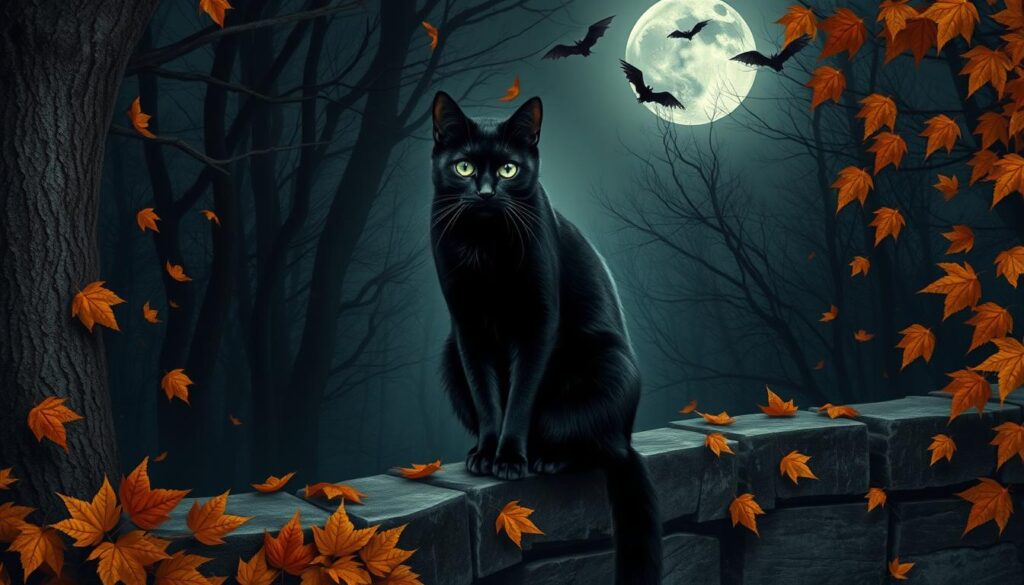
“The association between black cats and bad luck dates back to the 13th century when they were declared an incarnation of Satan by Pope Gregory IX in 1233.”
Halloween Colors: Black and Orange
Black and orange are the top colors for Halloween. They have been linked with the holiday for centuries. The ancient Celts saw black as the end of summer and orange as the harvest time.
Businesses started using these colors as Halloween became more popular. The Dennison Company introduced its first Halloween decorations in 1909. The Beistle Company also used black and orange, making them a big part of Halloween.
Now, orange is linked with fire and the fall harvest. Black is seen as the night and mystery. These colors show the change from summer to winter.
Yellow and brown were once big for Halloween, but orange took over thanks to pumpkins. Black became popular with bats and black cats, key Halloween symbols.
In recent years, purple and green have joined the Halloween colors. Purple adds a regal feel, while green brings mystery and spirituality.
Color affects us deeply, making it key in marketing for Halloween. Black and orange, with new colors, have made the holiday’s colors unforgettable. They’re a big part of what makes Halloween special.
Bobbing for Apples
The game of bobbing for apples has been a favorite at Halloween for many years. It started in a time when love was in the air. People used to play this game as a way to honor Pomona, the goddess of farming and plenty.
When the Romans came to the British Isles in 43 AD, they brought the Pomona festival with them. It mixed with the Celtic Samhain celebration, which is now Halloween. This mix made bobbing for apples a key part of Halloween.
In the 14th century, the game was shown in a book called The Luttrell Psalter. It showed how deep this tradition went in British culture. Young women who were not yet married would play this game. They thought the first one to bite an apple would soon get married.
By the 1800s, the game was less popular in Ireland and England. But, it came back in the United States by the end of the century. Now, bobbing for apples is a big part of Halloween and harvest festivals.
The game is simple. Players sit by a tub of water and try to grab an apple with their mouth. Sometimes, there are coins or other surprises in the apples. In another version, apples are hung high for players to bite.
Even though the love story behind bobbing for apples is mostly forgotten, it’s still a big part of Halloween fun. People all over the world enjoy this spooky and festive tradition.
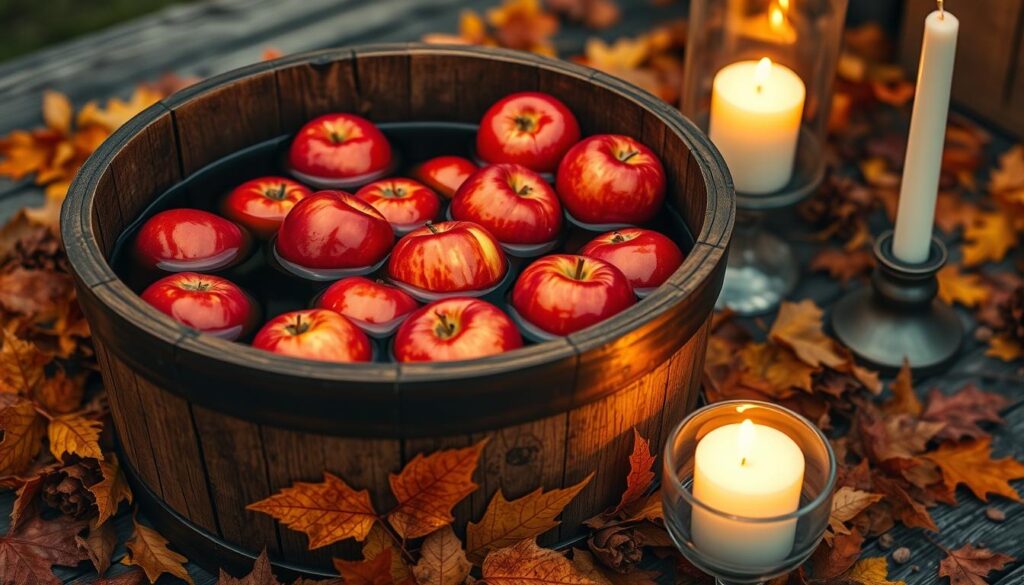
| Bobbing for Apples: A Centuries-Old Tradition |
|---|
|
Halloween Pranks and Mischief
Halloween is known for its playful tricks and mischief. These traditions come from ancient Celtic festivals and Irish and Scottish immigrants. For many years, pranks have been a big part of Halloween.
Back in the early 1900s, Americans loved to soap windows, ring doorbells, and pull fire alarms on Halloween. This playful chaos led to efforts to make the holiday safer for kids.
By the 20th century, trick-or-treating became popular as a way to stop destructive Halloween pranks and mischief. By the 1950s, towns managed to reduce vandalism on Halloween, focusing on kids.
Now, Halloween pranks and mischief are more friendly and community-based. Americans spend about $6.9 billion on Halloween each year, making it the second biggest holiday for spending. While some pranks still happen, the main focus is on having fun together.
“A postcard from 1908 illustrates Halloween mischief and pranks, reflecting the historical indulgence in mischievous activities during the celebration.”
As Halloween changes, finding a balance between fun mischief and safe celebration is key. This balance keeps Halloween pranks exciting and appealing.
Bonfires and Candle Lighting
The origins of Halloween go back over 2,000 years to the ancient Celtic festival of Samhain. The Celts thought the veil between the living and the dead was thin during this time. They believed spirits could roam the Earth. To keep these spirits away, they lit huge bonfires and offered sacrifices of crops and animals.
Now, the big bonfires of old are mostly gone. But, the tradition lives on in a gentler way with candles. Lighting candles today is a way to remember loved ones who have passed. It also adds a cozy, festive feel to Halloween.
Lighting candles on Halloween comes from the medieval tradition of ringing church bells and lighting candles for All Souls’ Day. This day is on November 2nd. The ceremonies were solemn and included ringing bells to keep evil spirits away.
Today, the soft glow of bonfires and candle lighting still plays a big part in Halloween. Carving jack-o’-lanterns and setting out luminaries add to the magic. These flames create a spooky yet magical atmosphere for the holiday.
| Tradition | Description | Origin |
|---|---|---|
| Bonfires | Large, roaring fires used to ward off evil spirits during the Celtic festival of Samhain | Over 2,000 years ago |
| Candle Lighting | Symbolic practice of lighting candles to remember the dead, often on All Souls’ Day | Medieval era |
The traditions of bonfires and candle lighting on Halloween still enchant us. They connect us to the holiday’s rich history and cultural importance.
Candy Apples and Candy Corn
Halloween is famous for candy apples and candy corn. These treats are key parts of the spooky season. Each has its own history and traditions.
Candy apples have been a Halloween favorite for over a century. They come from the Roman festival of Pomona, the goddess of farming and plenty. Over time, candy apples became a symbol of the harvest and the season’s plenty.
Candy corn is a newer Halloween treat. It was first made in the 1880s in Philadelphia. But it became popular in 1898 thanks to the Goelitz Confectionery Company. In the 1950s, as trick-or-treating became more common, candy corn became a must-have Halloween candy.
Now, over 35 million pounds of candy corn are made every year. October 30th is National Candy Corn Day. This candy is sweet with sugar, butter, honey, and vanilla. Some kinds even have real honey for a natural taste. It’s firm, chewy, and a bit hard outside, like a meringue.
Do you like the crisp taste of candy apples or the sweet taste of candy corn? These Halloween treats still bring joy to kids and adults alike. This year, make sure to enjoy these classic sweets and get into the holiday spirit.
“Candy corn is the candy corn of Halloween.”
Bats and Haunting Creatures
Bats might seem spooky, but they’re vital to our world. They’re often linked to Halloween because of the ancient Celtic festival of Samhain. But they’re more than just symbols of fear.
There are three types of vampire bats. These include the Common Vampire Bat, the Hairy-Legged Vampire Bat, and the White-Winged Vampire Bat. Yet, they’re a tiny part of the over 1400 bat species, living only in Central and South America.
- Bats are key to our ecosystem. They eat pests, help pollinate plants, and spread seeds.
- Vampire bats don’t usually look for humans to eat. Feeding on humans is rare.
- About 70% of tropical fruits eaten by humans are thanks to bats.
It’s important to teach others about bats to protect them. Adding a bat house, like a BatBnB, helps bats and supports their conservation.
Bats might have been at the first Halloween celebrations. The ancient Celts thought Halloween was when the spirit world was closest to ours. This led to a long history of haunting creatures being linked to the holiday.
“Over 100,000 people were accused of witchcraft in Europe during witch hysteria, resulting in upwards of 50,000 executions.”
The Salem Witch Trials ended the mass hysteria against witches. But the idea of haunting creatures at Halloween lives on, thanks to Irish immigrants in the 19th century.
Conclusion
Halloween’s history is a fascinating story that goes back centuries and crosses cultures. It started with the ancient Celtic festival of Samhain. Now, it’s a holiday filled with costumes, candy, and haunted places. Over time, it has kept its core elements of honoring the supernatural and embracing the mysterious.
The Roman traditions, Christian beliefs, and European immigrants have all shaped Halloween in the U.S. and worldwide. Whether you’re carving pumpkins, trick-or-treating, or just enjoying the festive vibe, Halloween’s history is part of its charm.
This holiday connects us to the past while letting us make new traditions and memories. As you celebrate this spooky season, appreciate the rich traditions that have made Halloween what it is today.
The origins of Halloween still capture the hearts of people everywhere. They remind us that old customs can last and change with the times. Embracing the Halloween spirit means celebrating togetherness, the supernatural, and the traditions that have lasted through the ages.
FAQ
What are the origins of Halloween?
Halloween started thousands of years ago with the ancient Celtic New Year’s festival of Samhain. This was a time when the veil between the living and the dead was thin. Spirits of the dead roamed freely.
What is the Celtic festival of Samhain?
Samhain, meaning “summer’s end,” was a festival marking the end of summer and the start of the new year. The Celts believed the veil between worlds was thinnest then. They lit sacred bonfires for sacrifices to their deities.
How did Roman festivals influence Halloween?
When the Roman Empire conquered Celtic lands, they merged their festivals with Samhain. Feralia honored the dead, and Pomona celebrated fruit and trees. This mix likely led to bobbing for apples.
How did Christian traditions shape Halloween?
In the 8th century, the Catholic Church created All Saints’ Day on November 1 to honor saints. The next day, All Souls’ Day, was for remembering the dead. This helped replace Samhain with a Christian holiday, now known as Halloween.
How did Halloween evolve in America?
Early American Halloween was rare in New England due to strict beliefs. But it thrived in Maryland and the South. Irish immigrants, fleeing the Potato Famine, helped make Halloween popular across the U.S. in the 19th century.
What is the origin of carving jack-o’-lanterns?
Carving jack-o’-lanterns began in Ireland with turnips, not pumpkins. It’s linked to a legend about Stingy Jack, who tricked the Devil. Irish immigrants later used pumpkins, which were easier to find.
What are the origins of trick-or-treating?
Trick-or-treating’s roots are unclear, but theories include ancient Celtic food offerings and Scottish “guising.” This practice involved children asking for food and money in exchange for prayers on All Souls’ Day.
Why do people wear scary costumes and masks on Halloween?
The Celts wore disguises to avoid spirits during Samhain. Over time, this became wearing scary costumes on Halloween.
Where does the superstition about black cats come from?
Black cats were feared in the Middle Ages as symbols of the Devil. Accused witches often had black cats, leading people to believe they were “familiars” – supernatural helpers. This linked black cats with spookiness.
Why are the traditional Halloween colors black and orange?
Black and orange come from Samhain. Black symbolized summer’s end, and orange represented the harvest.
Where does the tradition of bobbing for apples come from?
Bobbing for apples is a Halloween favorite with roots in a Roman courting ritual. It blended with Samhain, becoming part of Halloween.
What are the origins of Halloween pranks and mischief?
Pranks vary by region, but “Devil’s Night” is a key tradition. It may have started with May Day or Samhain celebrations. Irish and Scottish immigrants brought these customs to America.
What is the history behind bonfires and candle lighting for Halloween?
Bonfires once lit the way for spirits at Halloween. Now, candles are used instead.
What are the origins of Halloween treats like candy apples and candy corn?
Candy apples trace back to the Roman Pomona festival. Candy corn was invented in the 1880s but became popular in the 1950s with trick-or-treating.
Why are bats associated with Halloween?
Bats were part of early Halloween celebrations, both in spirit and reality. They were attracted to Samhain bonfires, linking them to the festival. Medieval folklore made them symbols of death.
